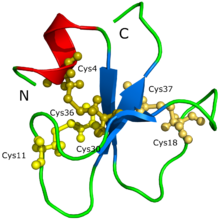- Myotoxin
-
Myotoxin 
Structure of crotamine, a Na+ channel affecting toxin from Crotalus durissus terrificus venom.[1] Identifiers Symbol Myotoxins Pfam PF00819 InterPro IPR000881 PROSITE PDOC00435 SCOP 1h5o Available protein structures: Pfam structures PDB RCSB PDB; PDBe PDBsum structure summary
Myotoxins are small, basic peptides found in snake venoms, such as in that of certain rattlesnakes[2][3]. This involves a non-enzymatic mechanism that leads to severe muscle necrosis. These peptides act very quickly, causing instantaneous paralysis to prevent prey from escaping and eventually death due to diaphragmactic paralysis.The first myotoxin to be identified and isolated was crotamine, from the venom of Crotalus durissus terrificus, a tropical South American rattlesnake, by Brazilian scientist José Moura Gonçalves, in the 1950s. Its biological actions, molecular structure and gene responsible for its synthesis were all elucidated in the last two decades.
References
- ^ Nicastro G, Franzoni L, de Chiara C, Mancin AC, Giglio JR, Spisni A (May 2003). "Solution structure of crotamine, a Na+ channel affecting toxin from Crotalus durissus terrificus venom". Eur. J. Biochem. 270 (9): 1969–79. doi:10.1046/j.1432-1033.2003.03563.x. PMID 12709056.
- ^ Griffin PR, Aird SD (1990). "A new small myotoxin from the venom of the prairie rattlesnake (Crotalus viridis viridis)". FEBS Lett. 274 (1): 43–47. doi:10.1016/0014-5793(90)81325-I. PMID 2253781.
- ^ Samejima Y, Aoki Y, Mebs D (1991). "Amino acid sequence of a myotoxin from venom of the eastern diamondback rattlesnake (Crotalus adamanteus)". Toxicon 29 (4): 461–468. PMID 1862521.
Categories:- Vertebrate toxins
- Muscular system
Wikimedia Foundation. 2010.
